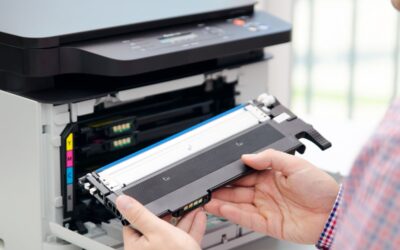It ensures high-quality patient care, regulatory compliance, and optimized workflow automation.
Healthcare facilities handle many documents, including patient records, insurance forms, administrative paperwork, and regulatory documents. To navigate this complex environment, healthcare providers increasingly rely on document management services to streamline their operations.
This article discusses how document management systems in healthcare can improve efficiency for medical staff.
The Challenge of Healthcare Document Management Solutions
Healthcare organizations face many challenges with securely storing and managing documents. Traditional paper documents are cumbersome, prone to errors, and lack the ability to keep pace with rapidly evolving healthcare security and compliance regulations.
Strict regulatory requirements, such as HIPAA (Health Insurance Portability and Accountability Act), impose stringent guidelines for the handling and storing of sensitive patient information. This adds to the complexity of document management processes.
Healthcare Document Management Services Benefits
- Enhanced Accessibility:
Document management services enable healthcare providers to digitize and centralize their documents, making them easily accessible to authorized personnel from any location. This ensures timely access to critical information, facilitating faster decision-making and improving patient care. - Improved Efficiency:
By automating manual document-related tasks, healthcare document management software can help healthcare professionals save time and resources. This includes data entry, indexing, and retrieval. By streamlining workflows, healthcare professionals can focus more on patient care than administrative duties. - Enhanced Security and Compliance:
Document management services provide robust security features, including encryption, access controls, and audit trails to safeguard sensitive patient information. This helps mitigate the risk of data breaches and non-compliance penalties. - Cost Savings:
Transitioning to electronic document management can save costs by eliminating paper storage, printing, and manual handling. Improved efficiency leads to reduced labor costs and increased productivity. - A scalable solution:
Document management services offer real-time scalability, allowing healthcare organizations to adjust to changing needs and expand without investing heavily in infrastructure. These services can scale to meet any organization‘s demands, from small clinics to extensive hospital networks.
Implementation Considerations
When implementing document management services in a healthcare setting, it is essential to consider these factors.
- Integration with Existing Systems: Maximize collaboration and data exchange by seamlessly integrating with existing Electronic Health Record (EHR) systems and other healthcare applications.
- User Training and Support: Train staff and provide ongoing support to ensure effective use of the document management system.
- Data Migration and Conversion: Ensure seamless migration of paper and electronic documents, preserving data integrity and quality of care.
- HIPAA Compliance: Ensure the software adheres to the Health Insurance Portability and Accountability Act (HIPAA) regulations for protecting patient health information privacy and security.
Features to look for in Healthcare Document Management:
Security Features
- Encryption: Data encryption capabilities to protect sensitive patient information both at rest and in transit.
- Access Controls: Granular access controls and user permissions restrict access to authorized personnel based on roles and responsibilities.
- Audit Trails: Detailed audit trails that track document access, modifications, and user activities for compliance auditing and monitoring purposes.

Document Capture and Management Features
- Document Capture: Robust scanning and digitization capabilities to convert paper-based documents into electronic format efficiently.
- Document Indexing: Automatic indexing and metadata tagging to organize and categorize documents for easy retrieval.
- Version Control: Versioning capabilities to track document revisions and ensure that users access the most up-to-date information.
Workflow Automation
- Automated Workflows: Workflow automation features to streamline document-centric processes such as approvals, notifications, and document routing.
- OCR Technology: Optical Character Recognition (OCR) technology extracts text from scanned documents, making them searchable and editable.
Scalability and Flexibility
- Scalability: Scalable architecture that can accommodate the growing volume of documents and users as the organization expands.
- Customization: Ability to customize workflows, templates, and user interfaces to align with specific organizational requirements and workflows.
User-Friendly Interface
- Intuitive Design: User-friendly interface with an intuitive layout and navigation to facilitate staff members’ ease of use and adoption.
- Mobile Access: Support for mobile devices such as smartphones and tablets to enable access to documents on the go.
Data Backup and Disaster Recovery
- Backup and Recovery: Robust data backup and disaster recovery mechanisms to protect against data loss and ensure business continuity during system failures or disasters.
Cost and ROI
- Total Cost of Ownership: Consideration of the total cost of ownership, including upfront licensing fees, implementation costs, ongoing maintenance, and support expenses.
Is BDS The Right Partner for Your Healthcare Document Needs?
Choosing BDS can streamline your healthcare business’s technology and processes, saving you time and money while maintaining HIPAA compliance. Our team of professionals specializes in crafting cost-effective workflows that enhance efficiency, allowing you to dedicate more attention to your patients.
From equipment leasing to printer fleet management, document management, and copier ink and toner subscriptions, our technicians will collaborate closely with you every step of the way.
Choose BDS for Your Document Management Needs in New England and Florida
At BDS, we recognize the importance of efficient document management in today’s fast-paced business environment. Serving New England and Florida, we provide customized solutions that streamline workflows, enhance security, and reduce costs. Whether you need a secure digital platform or automated document processing, our team delivers tailored strategies to meet your business objectives. With cutting-edge technology and user-friendly tools, BDS helps your team focus on delivering exceptional results.






